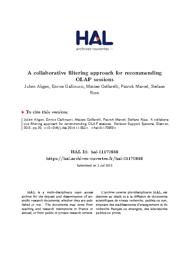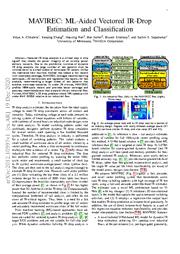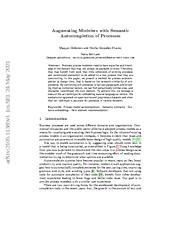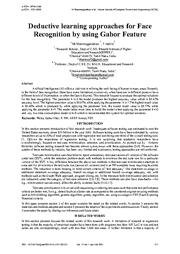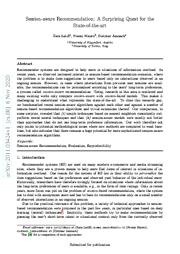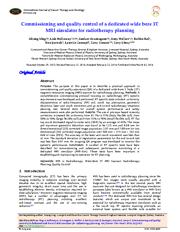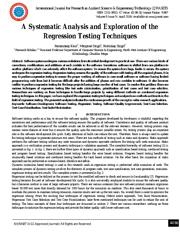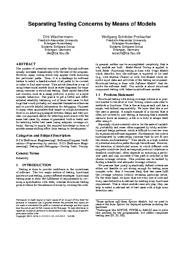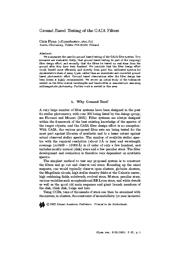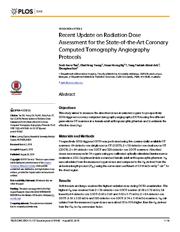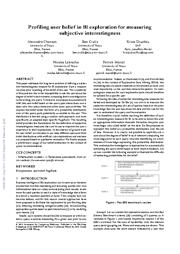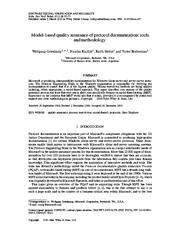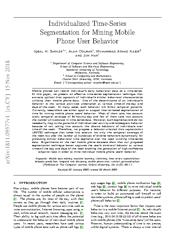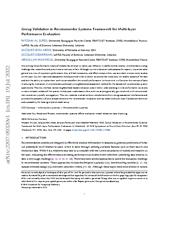A copy of this work was available on the public web and has been preserved in the Wayback Machine. The capture dates from 2019; you can also visit the original URL.
The file type is application/pdf.
Filters
A collaborative filtering approach for recommending OLAP sessions
2015
Decision Support Systems
After describing our approach, we discuss the results of a large set of effectiveness and efficiency tests based on different measures of recommendation quality. ...
To address this issue, in the paper we propose a recommendation approach stemming from collaborative filtering. ...
When the minimum relevance is 0 no filtering of base recommendations is made, so coverage is about 90%. ...
doi:10.1016/j.dss.2014.11.003
fatcat:oyuz4oehyvgppn62yqskx7fzre
MAVIREC: ML-Aided Vectored IR-DropEstimation and Classification
[article]
2020
arXiv
pre-print
recommending a larger subset of test patterns that exercise worst-case scenarios. ...
Vectored IR drop analysis is a critical step in chip signoff that checks the power integrity of an on-chip power delivery network. ...
per-region using worst-case IR
• Rank each slice for every region based on score
• Top
recommended slices can be run in an
industrial flow for validation
Sort and prune slices
based on slice power ...
arXiv:2012.10597v1
fatcat:s2r56jasezc6domgnlnyd6nn4e
Augmenting Modelers with Semantic Autocompletion of Processes
[article]
2021
arXiv
pre-print
In this paper, we present a method for process autocompletion at design time, that is based on the semantic similarity of sub-processes. ...
By converting sub-processes to textual paragraphs and encoding them as numerical vectors, we can find semantically similar ones, and thereafter recommend the next element. ...
Process Matching and Element Autocompletion Our solution makes its recommendations based on the best matching slice that it finds in its input dataset. ...
arXiv:2105.11385v1
fatcat:3j5n7xna5fabjcsyx4cjqsfixu
Friends, Strangers, and the Value of Ego Networks for Recommendation
[article]
2013
arXiv
pre-print
We find that recommendation algorithms based only on friends perform no worse than those based on the full network, even though they require much less data and computational resources. ...
These results help us understand when, and why, social network information is likely to support recommendation systems, and show that systems that see ego-centric slices of a complete network (such as ...
We divide each core user's preference data into 70:30 train-test splits (using 30% test items means even users with few likes have at least one in the test set) and make top-10 recommendation lists using ...
arXiv:1304.4837v1
fatcat:2j5uijmkkbcrrpb3omyvuwzffq
Deductive learning approaches for Face Recognition by using Gabor Feature
2021
Indian Journal of Computer Science and Engineering
The model takes more time to build the model when applying the parameter k=10 and very low time consumption model is k=8 which is recommended this system for optimal solutions. ...
The reduction is done keeping in mind certain criteria of "test adequacy" like statement coverage or additional statement coverage adequacy, branch coverage or additional branch coverage adequacy, etc. ...
with methods such as the Graph-Walk approach, program slicing, etc. ...
doi:10.21817/indjcse/2021/v12i1/211201251
fatcat:4ukls2mr2rbb7hlijlxjr2ruue
Session-aware Recommendation: A Surprising Quest for the State-of-the-art
[article]
2020
arXiv
pre-print
Recommender systems are designed to help users in situations of information overload. ...
In recent years, we observed increased interest in session-based recommendation scenarios, where the problem is to make item suggestions to users based only on interactions observed in an ongoing session ...
We finally filter out the items from validation and test sets of each five slices that did not appear in the training set of that slice. Target Item Selection. ...
arXiv:2011.03424v1
fatcat:tl6lorex6fdhdn73rq3dw46jdm
Commissioning and quality control of a dedicated wide bore 3T MRI simulator for radiotherapy planning
2016
International Journal of Cancer Therapy and Oncology
General tests for overall system performance and safety measurements were also performed. ...
The standard deviation of registration parameters for the end-to-end test was less than 0.41 mm. An on-going QA program was developed to monitor the system's performance. ...
The selection of tests and tolerance was mainly based on the observation of system performance over last two years. ...
doi:10.14319/ijcto.42.1
fatcat:2hvei5wq2jfdpkuuzfqziwlhim
A Systematic Analysis and Exploration of the Regression Testing Techniques
2018
International Journal for Research in Applied Science and Engineering Technology
Sometimes, software is shifted from one platform to another platform which can adversely affect the software system. ...
Researchers are working on these techniques to handle large projects by using different methods on mentioned regression testing techniques. ...
Authors presented the methods of novel proposed model, filtering based selection, code coverage based and original regression test. ...
doi:10.22214/ijraset.2018.4671
fatcat:ee2mzqwpwjcover33oeaujokzm
Separating testing concerns by means of models
2010
Proceedings of the 1st Workshop on Testing Object-Oriented Systems - ETOOS '10
(by means of generated built-in tests) and for selecting better test cases (using adequate coverage criteria). ...
Opposed to many other approaches that target on a high automation level or on achieving synergies between design and test process, our approach allows for detecting more errors with the same test cases ...
For getting started with model-based testing, we recommend the "Taxonomy of model-based testing" [26] , which is quite self-contained. ...
doi:10.1145/1890692.1890698
fatcat:6koiwdvqrzfn7mnrix3y2mbviy
Ground Based Testing of the GAIA Filters
[chapter]
2002
Census of the Galaxy: Challenges for Photometry and Spectrometry with GAIA
We summarise the case for ground based testing of the GAIA filter system. ...
Two scenarios are evaluated; firstly, that ground based testing be part of the (ongoing) filter design effort, and secondly that the filters be tested on real stars from the ground after they have been ...
The disadvantages of ground based testing are clear. ...
doi:10.1007/978-94-010-0361-2_27
fatcat:dju5o4vrbrcfndh4lo23pc2rla
Recent Update on Radiation Dose Assessment for the State-of-the-Art Coronary Computed Tomography Angiography Protocols
2016
PLoS ONE
The radiation doses received from a prospectively ECG-triggered CCTA are relatively small and are depending on the scanner technology and imaging protocols. ...
Radiation Dose Assessment in Coronary Computed Tomography Angiography PLOS ONE | Fig 2. a) Positioning of phantom according to the clinical CCTA settings; b) SPR image of phantom with the scan range planned ...
Fourth, a new tin-based selective photon shield was used to filter unnecessary low energy photons from the high energy X-ray tube spectrum. ...
doi:10.1371/journal.pone.0161543
pmid:27552224
pmcid:PMC4994944
fatcat:sruv5yavbvcuxfjzwxndcn3w2u
Profiling User Belief in BI Exploration for Measuring Subjective Interestingness
2019
International Workshop on Data Warehousing and OLAP
In the absence of ground truth for user belief, we simulate in our tests different users and their belief distributions with artificial cube explorations and evaluate our proposal based on qualitative ...
To this aim, we propose to automatically infer this user belief based on the user's past interactions over a data cube, the cube schema and other users' past activities. ...
The right-side of Figure 6 describes how we generate the test belief based on the recommender system [1] and a simulated user of the recommender system. ...
dblp:conf/dolap/ChansonCDLM19
fatcat:5x4hvqv4lrgg5lvzjgnej64wbe
Model-based quality assurance of protocol documentation: tools and methodology
2011
Software testing, verification & reliability
This paper describes core aspects of the quality assurance process and tools that were put in place, and specifically focuses on model-based testing (MBT). ...
Various test-driven methods are being applied including, when appropriate, a model-based approach. ...
framework for test conformance is not based on finite state machine test theory, but on transition systems and alternating simulation [11] . ...
doi:10.1002/stvr.427
fatcat:vewoijeghrd7tlxsd3puglgt6m
Individualized Time-Series Segmentation for Mining Mobile Phone User Behavior
2017
Computer journal
Currently, researchers use either equal or unequal interval-based segmentation of time for mining mobile phone users' behavior. ...
Most of them take into account static temporal coverage of 24-hours-a-day and few of them take into account the number of incidences in time-series data. ...
Zhu et al. [6] use five static
time segments in a day and predefined as morning
[7:00-11:00], noon [11:00-14:00], afternoon [14:00-18:00]
and so on in their recommendation system. ...
doi:10.1093/comjnl/bxx082
fatcat:jxxe62cuvvd57nmidizgrckevq
Group Validation in Recommender Systems: Framework for Multi-layer Performance Evaluation
[article]
2022
arXiv
pre-print
In this article, we focus on the concept of data clustering for evaluation in recommenders and apply a neighborhood assessment method for the datasets of recommender system applications. ...
This new method, named neighborhood-based evaluation, aids in better understanding critical performance variations in more compact subsets of the system to help spot weaknesses where such variations generally ...
Our approach is built specifically for recommender systems rating-based datasets and uses a different strategy (clustering-based) for forming groups compared to the one utilized in [7] to form data slices ...
arXiv:2207.09320v1
fatcat:lu3pn475ojalpgnuajhoaxrsa4
« Previous
Showing results 1 — 15 out of 14,398 results

